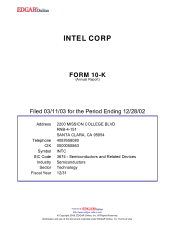Intel 2002 Annual Report Download - page 7
Download and view the complete annual report
Please find page 7 of the 2002 Intel annual report below. You can navigate through the pages in the report by either clicking on the pages listed below, or by using the keyword search tool below to find specific information within the annual report.
Chipsets
If the microprocessor is considered the "brains" of the PC, the chipset operates as the PC's "nervous system"—sending data from the
processor to all the input, display and storage devices, such as the keyboard, mouse, monitor, hard drive, and CD or DVD drive. Chipsets
perform essential logic functions supporting the CPU, such as balancing the performance of the system and removing bottlenecks; they also
extend the graphics, audio, video and other capabilities of many systems based on our processors. Our chipsets are compatible with one or more
of a variety of industry-accepted bus specifications, such as the Peripheral Components Interconnect (PCI) local bus specification and the
Accelerated Graphics Port (AGP) specification. A bus is a circuit that carries data between parts of the system, for example, between the
processor and main memory. Our customers demand memory architecture alternatives, and as a result, we currently offer chipsets supporting
Double Data Rate (DDR) Dynamic Random Access Memory (DRAM), Synchronous DRAM (SDRAM) and Rambus* DRAM (RDRAM).
4
To help computer makers reduce the time-to-
market for their products, we design, manufacture and sell chipsets for each computing market
segment. In May 2002, we introduced the Intel® 845G, 845E and 845GL chipsets. These chipsets include integrated Hi-Speed Universal Serial
Bus (USB) 2.0, which increases USB bandwidth up to 40 times compared to the previous USB 1.1 interface. The Intel 845G chipset is designed
for PCs based on the Intel Pentium 4 microprocessor and incorporates both a new generation of integrated graphics capabilities and software
drivers. The Intel 845E chipset works with specific graphics components to provide flexibility for makers of Pentium 4 microprocessor-based
systems, while the Intel 845GL chipset is designed for PCs based on the Intel Celeron microprocessor.
In May 2002, we introduced the Intel® 850E chipset, complementing the Pentium 4 processor's 533-MHz system bus for higher
performance desktop PCs. In October 2002, we introduced an enhanced Intel 850E chipset and three new chipsets—the Intel® 845GE, 845PE
and 845GV chipsets—all supporting our HT Technology and utilizing high-speed system buses to maximize the performance of the Pentium 4
processor.
In March 2002, we introduced the Intel® 845MP chipset for the Mobile Pentium 4 Processor-M. The new chipset supports the enhanced
Intel SpeedStep® technology (which improves power management in mobile computers), and supports external AGP 4X graphics, a 400-MHz
processor system bus and DDR 266-MHz SDRAM. In addition, in January 2003, we introduced the Intel® 852GM integrated graphics chipset,
also supporting enhanced Intel SpeedStep technology. The Intel 852GM chipset includes six integrated Hi-Speed USB 2.0 ports.
For workstation and server makers, in February 2002 we introduced the Intel® E7500 chipset, which is optimized for the Intel Xeon
processor and supports DDR memory technology. The E7500 chipset enables twice the memory bandwidth of legacy SDRAM platforms. In
November 2002, we introduced the Intel
® E7501 chipset for two-way servers and the embedded computing market segment; the Intel® E7505
chipset for two-way workstations using Intel Xeon processors; and the Intel® E7205 chipset for single processor, entry-level workstations based
on the Intel Pentium 4 processor.
Board-Level Products
To help proliferate our microarchitectures through all of our computing market segments, we offer board-level products based on our
microprocessors. While many of our OEM customers use our microprocessors as components in designing their own computer products, some
also use board-level products that we design and build. OEMs may purchase products from us at this level of integration to reduce their time-to-
market and to direct their investments to other areas of their product lines. We provide board-level products to give our OEM customers
flexibility by enabling them to choose whether to buy at the component or board level.
Sales and Gross Margin
For 2002, the majority of our consolidated net revenue and gross margin came from sales of the Intel Pentium 4 microprocessor and related
microprocessors based on the Intel NetBurst microarchitecture, as well as related chipsets and boards. Sales of the Pentium III microprocessor
and related microprocessors based on the P6 microarchitecture, as well as related products, made up a significant but steadily decreasing portion
of our consolidated net revenue and gross margin. During 2001, sales of microprocessors based on the P6 microarchitecture and related board-
level products and chipsets made up the majority of our consolidated net revenue and a substantial majority of our gross margin. For the same
period, sales of products based on the Intel NetBurst microarchitecture and related products were a significant and rapidly increasing portion of
our consolidated net revenue and gross margin. For 2000, sales of microprocessors based on the P6 microarchitecture and related products made
up a substantial majority of our consolidated net revenue and gross margin.
Wireless Communications and Computing Group
The Wireless Communications and Computing Group provides component-level building blocks for digital cellular communications and
other applications requiring both low-power processing and high performance. Our strategy is to deliver complete solutions that enable quick
deployment of applications and services for wireless Internet and handheld computing devices such as cell phones, personal digital assistants
(PDAs) and smart displays. Our current products for the handheld platform include flash memory, processors based on the Intel® XScale™
microarchitecture, and cellular baseband chipsets.




















